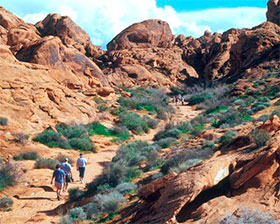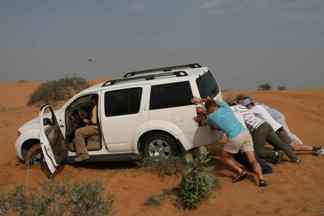Hoover Dam Police Department - Safeguarding a National Icon
Desert Safety Tips
To report an emergency situation at Lake Mead or Lake Mohave
or anywhere on Lake Mead National Recreation Area lands,
contact the National Park Service 24-hour Communications Center at
702-293-8932 or 1-800-680-5851, or notify the nearest Park Ranger.
To report an emergency situation at Hoover Dam,
dial 911 and/or 702-293-8998,
or contact the nearest Dam employee.
Hoover Dam is a wonderful place to visit, but several factors must be kept in mind when touring the site or exploring the desert lands around it. Weather conditions change rapidly and it's best to be prepared for any situation. Here are a few tips to keep in mind to stay safe during your visit:

Carry Plenty of Water
There are no dependable sources of water in the desert regions. One gallon of water per person, per day is the absolute minimum that should be carried. When planning a hike, remember that water weighs approximately 8 pounds per gallon. When the water is half gone, it is time to turn back. Don't forget extra water for your vehicle. DO NOT RATION YOUR WATER. It will only do you good if you drink it.
Plan Your Trip Carefully
Always tell someone where you are going and when you will return. Stick with your itinerary, and let them know when you return. Do not travel in the desert backcountry without taking along appropriate maps such as US Geological Survey topographic maps, which show land contours and specific features. Learn how to use a topographic map and a compass before you hike cross-country or on trails that are not well defined. It is easy to become disoriented in the desert where many landmarks and rock formations look similar.
Dress Properly
In summer, layered clothing slows dehydration and minimizes exposure. Good walking shoes, loose fitting natural-fiber clothing, a wide brimmed hat, sunglasses and sunscreen are a must. Desert temperatures can reach over 90° F. and drop below 50° F. in one day. Summer temperatures can reach 125° F. in some locations. In winter, temperatures can often drop below freezing. Bring extra warm clothing.
Avoid Flash Floods
When a violent thunderstorm breaks over the mountains and deserts of the southwest, runoff from the torrential rains cascades into the steep canyons in a matter of minutes. Walls of water sometimes 10 to 30 feet high swirl through the canyons and arroyos, picking up mud, boulders, trees and other debris. Plants, animals and sometimes people are caught, swept along and battered in the onrushing torrent of the flash flood. Flash floods can result from thunderstorms centered over mountains many miles away.
Flash floods can occur in the southwestern United States at any time of the year, but the predominant seasons are summer and early fall. They can occur as the result of: Isolated thunderstorms -- late June to mid-September; Tropical storms or other general storms -- mostly August to October. Remember:
- Keep an eye and ear to the sky. Be alert for thunder or lightning in your vicinity and over nearby hills.
- Listen frequently to weather reports on radio.
- Avoid deep canyons and dry washes during stormy or threatening weather.
- If heavy rains occur, move to high ground immediately (at least 30 to 40 feet above the canyon floor or bottom of the dry wash).
- If you can't move your vehicle, abandon it. Don't attempt to return to your vehicle until the sky clears or officials give you the OK.
- Don't try to drive through flooded areas. Abandon your car if water begins to rise over the road. Move to high ground immediately.
- Follow instructions of local authorities. Leave immediately when warned. Many lives have been lost because people have not heeded warnings of police officers, park rangers and other officials.
- Before you leave home, inform someone of your destination and when you expect to return. Police should be notified immediately if you do not return on time.
Know Your Vehicle
Be sure your vehicle is in good condition with a sound battery, good hoses, spare tire, spare fan belts, necessary tools, and reserve gasoline and oil. Other spare parts and extra radiator water are also valuable.
If caught in a dust storm while driving, get off the road. Turn off driving lights, turn on emergency flashers. Back into the wind to reduce windshield pitting by sand particles.

Before driving through washes and sandy areas test the footing. One minute on foot may save hours of hard work or prevent a punctured oil pan.
If your vehicle breaks down, stay near it. Your emergency supplies are here. Your car has many other items useful in emergency. Raise hood and trunk lid to denote "Help needed." A vehicle can be seen for miles, but a person on foot is very difficult to find.
When not moving, use available shade or erect shade from tarps, blankets, seat covers - anything to reduce the direct rays of the sun.
Do not sit or lie directly on the ground. It may be 30 degrees or more hotter than the air.
Leave a disabled vehicle only if you are positive of the route to help.
Keep clothing on. It helps to keep the body temperature down and reduces the dehydration rate. Cover your head. If a hat is not handy, improvise a head covering.
If you must walk, rest for at least 10 minutes of each hour. If you are not normally physically active, rest up to 30 minutes out of each hour. Find shade, sit down and prop up feet. Adjust shoes and socks. Do not remove shoes - you may not be able to get them back on swollen feet.
If you have water, drink it. Do not ration it.
If water is limited, keep your mouth shut. Do not talk, do not eat, do not smoke, do not drink alcohol, do not take salt.
If stalled or lost set signal fires. Set smokey fires in the daytime, bright ones for the night. Three fires in a triangle denote "help needed."
A roadway is a sign of civilization. If you find a road, stay on it.
The Hoover Dam Police Department hopes your visit to the desert lands around Lake Mead and Hoover Dam is a safe and enjoyable one.
Return to Hoover Dam Police Homepage

